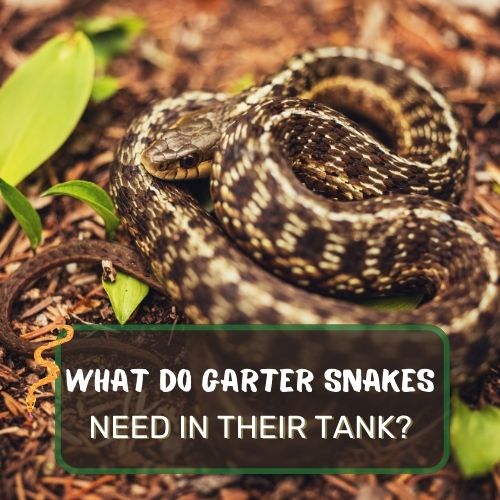Garter snakes, those slender, striped inhabitants of our gardens, often spark curiosity and intrigue. But have you ever wondered about their underground escapades or their role in our backyards?
Yes, garter snakes do burrow underground, but they’re opportunistic about it. Instead of digging their own tunnels, they often utilize existing holes or crevices for shelter, warmth, and protection. These burrows offer them a safe haven from predators and harsh weather conditions.
In this article, we’ll unravel the mysteries of garter snake burrowing habits, compare them with other burrowing snakes, and even guide you on identifying their hideouts in your yard.
From their ecological significance to frequently asked questions, we’ve delved deep to bring you a comprehensive insight into these fascinating creatures. Let’s embark on this serpentine journey together!

Table of Contents
Garter Snakes and Their Underground Adventures
These fascinating creatures have been the subject of many backyard tales and childhood memories. But there’s one question that often pops up: Do garter snakes burrow underground?
Let’s dive deep and unravel this mystery.
Tendency to Burrow Underground
Garter snakes, contrary to some popular beliefs, do have a tendency to go underground. Now, this doesn’t mean they’re digging elaborate tunnels like some sort of reptilian miners. No, these snakes are more opportunistic.
They’ll often seek out existing holes or cavities to slide into. Think of it as them taking advantage of the “real estate” that’s already available. It’s like finding a cozy, pre-furnished apartment – why build one from scratch when you can just move in?
Reasons: Warmth, Especially During Colder Winter Months
Imagine it’s a chilly winter day. The wind is howling, and there’s a nip in the air. Wouldn’t you want to snuggle up in a warm blanket? Garter snakes feel the same way, but instead of blankets, they seek the warmth of the earth.
The ground acts as a natural insulator. As temperatures drop, the underground becomes a haven for these cold-blooded creatures. It provides a consistent temperature, shielding them from the harsh winter cold.
This behavior is not just about comfort; it’s a survival tactic. By burrowing, garter snakes can avoid freezing temperatures that could be fatal.
Using Natural Cavities Like Rodent Burrows
Now, here’s where it gets interesting. Garter snakes aren’t the best diggers. They don’t have the tools or the physique for it.
So, how do they find these underground hideouts? Enter rodents. Rodents, like mice and chipmunks, are expert diggers.
They create intricate burrows and tunnels. Once these rodents move on or, let’s say, become a meal for a predator, these burrows become vacant. Garter snakes, being the opportunists they are, seize these opportunities.
They’ll move into these abandoned burrows, making them their own. It’s a classic example of one animal’s trash being another’s treasure.

Natural Shelters Garter Snakes Seek
When it comes to finding a place to chill, garter snakes are quite the connoisseurs. They’re not picky, but they sure know how to pick the best spots. Let’s embark on a journey through the natural shelters these slithering creatures are fond of.
Tree Hollows
Imagine the cozy nook of a tree hollow. It’s like the penthouse suite for garter snakes. These hollows, formed due to age, disease, or woodpecker activity, offer a snug and safe hideout.
Elevated from the ground, they provide protection from ground-dwelling predators and a vantage point to spot any potential prey or threats.
Under Logs
Logs are like the studio apartments of the snake world. Convenient, easy to access, and offering just the right amount of cover. Garter snakes often slide under fallen logs, taking advantage of the moisture, darkness, and relative warmth.
Plus, logs are often a hub of insect activity, making them a potential dining spot for our reptilian friends.
Leaf Litter
The forest floor, with its thick layer of decaying leaves, is like a blanket for garter snakes. They can easily burrow into this leafy layer, camouflaging themselves from predators and waiting stealthily for their next meal to pass by.
Underground Holes
We’ve touched upon this before, but it’s worth reiterating. The earth’s embrace is warm and welcoming. Garter snakes will often seek out pre-existing holes, sliding into them for protection and warmth. It’s like having a readymade home, no rent required!
Rock Outcroppings
Rocks and boulders, with their crevices and cracks, are a garter snake’s dream. These natural formations offer multiple entry and exit points, making them a strategic hideout.
Whether it’s evading a hawk overhead or basking in the sun’s filtered rays, rock outcroppings are versatile shelters.
Abandoned Burrows of Other Animals
The animal kingdom is full of builders. From moles to rabbits, many creatures dig burrows. But not all of them stay forever. When they leave, garter snakes see an opportunity.
Moving into these abandoned homes, they repurpose them, turning them into snake sanctuaries.

Why Garter Snakes are Beneficial for Gardens
Gardens and garter snakes – it sounds like an unlikely duo, right? But hold onto your gardening gloves, because these slithering residents can be a gardener’s best friend. Let’s delve into why.
Role in Controlling Pests
Every gardener’s nemesis? Pests. Those pesky insects and small rodents that nibble on plants and ruin the hard work. Enter garter snakes, the unsung heroes of natural pest control. They have an appetite for insects, slugs, and even those troublesome rodents.
With a garter snake around, there’s no need for chemical pesticides. They keep the garden’s ecosystem in check, ensuring your plants thrive.
Indicators of a Healthy Ecosystem
Spotting a garter snake in your garden is like getting a thumbs up from Mother Nature. It’s an indicator that your garden has a balanced ecosystem. A habitat where predators and prey coexist, where the soil is healthy, and where biodiversity thrives.
It’s nature’s way of saying, “You’re doing it right!”

Comparison of Garter Snake’s Burrowing Abilities with Other Burrowing Snakes
Garter Snakes: Known for their adaptability, garter snakes predominantly take the path of least resistance. Instead of actively digging, they’re opportunists, capitalizing on existing burrows, crevices, or spaces in their environment.
Their slender and agile bodies make it easy for them to navigate these spaces, providing them shelter and protection.
Hognose Snakes: These are the architects of the snake world. With their distinct upturned snouts, they’re equipped to dig and create burrows. Their burrowing is often driven by the need to find food, lay eggs, or seek refuge from predators.
Sand Boas: These snakes have a natural affinity for sandy terrains. Their bodies are designed to “swim” through sand, allowing them to burrow quickly and efficiently, making them masters of desert hide-and-seek.
Rattlesnakes: While they possess some burrowing capability, rattlesnakes often prefer the convenience of existing burrows, especially those made by rodents.
They might make minor modifications, but largely, they’re tenants rather than builders in the burrowing world.

Identifying Garter Snake Holes in Yards
Strolling through your garden, you might occasionally stumble upon a curious little hole and wonder, “Who’s been digging in my yard?” Well, it could be a garter snake’s hidey-hole. But how can you be sure?
Let’s delve into the world of snake real estate.
Characteristics of Snake Holes
Garter snake holes are typically not too large, given the snake’s slender body. They’re often:
- Circular and Clear: Unlike rodent burrows, which might have excavated dirt around the entrance, snake holes are usually clean with a clear, circular opening.
- Shallow: Garter snakes aren’t deep burrowers. Their holes might lead to a simple chamber or connect to a more extensive underground network, but they won’t be too deep.
- Camouflaged: These holes often blend seamlessly with the surroundings, making them a bit tricky to spot.
Tips for Identification
- Location: Garter snakes prefer moist areas. Check near water sources or damp spots in your garden.
- Tracks: Look for snake trails leading to the hole, especially in soft soil or sand.
- Absence of Excavated Dirt: Unlike rodents that leave a mound of dug-out soil, snake holes are cleaner.
- Watch and Wait: If you’re patient, observe the hole from a distance during warmer hours. You might just spot the snake emerging or entering its burrow.
Identifying garter snake holes can be a bit of a detective game, but with these clues, you’ll be well on your way to becoming a snake hole sleuth!

Conclusion
You’ve journeyed through the intriguing world of garter snakes, discovering their burrowing habits and their role in our gardens.
These adaptable creatures not only seek shelter underground but also play a vital role in controlling pests and indicating a healthy ecosystem.
As you venture into your garden or explore nature, remember to appreciate the subtle wonders these snakes bring to our environment. Keep observing, keep learning, and always cherish the delicate balance of nature around you.
Your newfound knowledge empowers you to coexist harmoniously with these fascinating reptiles. Keep exploring!
FAQ
Why is my garter snake burrowing?
Garter snakes burrow for various reasons. They seek refuge from predators, shelter from harsh weather conditions, or a cozy spot for hibernation. The earth’s consistent temperature also provides them with the warmth they need, especially during colder months.
How do you get a garter snake out of hiding?
Garter snakes are sensitive to vibrations. Gently tapping or creating slight vibrations near their hiding spot might encourage them to emerge. However, always ensure you handle them with care and respect, avoiding any sudden movements that might stress them.
What is the best snake repellent for garter snakes?
There are commercial snake repellents available, often made with ingredients like clove oil or naphthalene. However, their effectiveness varies. A more natural approach is to maintain a tidy yard, removing potential hiding spots like piles of wood or dense shrubs.
How can you tell if a snake is a garter?
Garter snakes have distinct longitudinal stripes running down their bodies. They’re generally slender and come in various colors, but the stripes are a common feature. Their heads are slightly wider than their necks, and they have round pupils, giving them a friendly appearance.




0 Comments